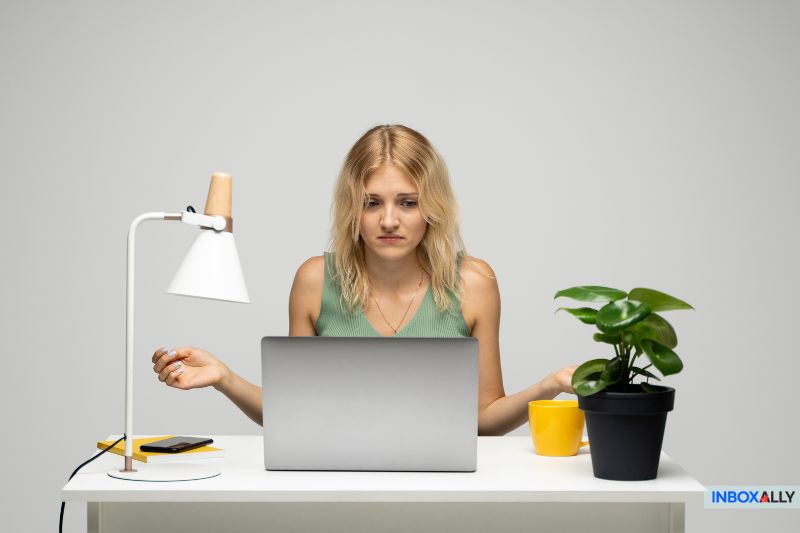You spend hours crafting the perfect email, hit send, and then…bounce notifications flood your inbox. Sound familiar? You’re not alone—email bounces are a common hurdle, but they have serious consequences.
A high bounce rate doesn’t just disrupt your communication; it can damage your sender reputation and cost you valuable opportunities. In this guide, we’ll explore why emails bounce and discuss proven strategies to ensure your messages land exactly where they’re meant to go.
What is an Email Bounce?
An email bounce happens when your emails cannot be delivered to their intended receivers. The sender’s email server will send a message which usually details what caused the email delivery failure.
Pro Tip: Save the bounce-back email, as it often contains important messages or error codes. Reviewing these details can help you understand why your email bounced and prevent similar issues in the future.
Soft Bounces vs. Hard Bounces: What’s the Difference?
There are two email bounces: a soft bounce (temporary) and a hard bounce (permanent).
Soft bounce
An email soft bounce means that the email address is valid and received by the recipient. However, it still bounces because the message or attachment was too large for the receiver’s inbox, the server may have crashed or is under maintenance, or the mailbox was full.
While soft bounces are typically temporary, repeated failed email deliveries can raise concerns. In some cases, it’s not just a full inbox or a server issue—your recipient might have intentionally blocked your email address.
If you’re unsure whether a specific contact has blocked you, understanding how to know if someone blocked you on Gmail can provide clarity. Identifying blocks early can help you adjust your outreach strategy and maintain your sender reputation.
This bounce is temporary since it can be easily remedied by fixing the server, shortening your campaign or newsletter, or having the recipient clean out their inbox.
![]()
Hard bounce
On the other hand, a hard bounce occurs when the email is rejected because the email address doesn’t exist or is invalid. This is a permanent type of email bounce and indicates a functionally useless contact. The non existent email address should be deleted from your list.
Soft bounces aren’t that bad, but hard bounces can degrade your email deliverability or do serious damage to your sender’s reputation.
Why Are My Emails Bouncing? Common Bounce Codes Explained
| Email Bounce Code | Type | Meaning | Recommended Action |
| 550 5.1.1 | Hard Bounce | Recipient address does not exist/It is the incorrect email address | Verify the email address or remove it from your list. |
| 553 5.1.2 | Hard Bounce | Syntax error in the recipient’s email address (e.g., typos or invalid format). | Correct the email address and resend. |
| 550 5.2.2 | Soft Bounce | Recipient’s mailbox is full (storage limit exceeded). | Notify the recipient to clear their mailbox or reattempt delivery later. |
| 554 5.7.1 | Rejected/Blocked | Message rejected due to suspected spam, insufficient permissions or spam complaints. | Check your sender reputation, email content, and request to be whitelisted. |
| 451 4.3.0 | Temporary Issue | Server is unavailable or busy. | Wait and try resending the email later. |
| 552 5.3.4 | Soft Bounce | Message size exceeds the server’s limit. | Reduce attachment size or use a cloud-sharing service for large files. |
| 421 4.4.0 | Temporary Issue | Server temporarily unavailable, usually due to connection or DNS issues. | Check the recipient’s server status or DNS settings, and retry after some time. |
| 250 2.0.0 | Delivered | Message successfully delivered (not a bounce). | No action needed. |
| 530 5.7.0 | Authentication | Authentication required to send messages through the server. | Ensure proper SMTP authentication or use an authenticated account to send emails. |
| 451 4.7.1 | Greylisting | Message deferred due to temporary server-side greylisting (anti-spam mechanism). | Wait and allow the server to retry automatically, or contact the recipient’s admin. |
Experiencing a ‘550 5.4.1 recipient address rejected: access denied’ error can indicate issues with the recipient’s email server or possible blocking. 550 5.4.1 recipient address rejected: access denied provides a detailed breakdown of what this error means and steps to resolve it, ensuring smoother email deliverability
A Closer Look at Why Emails Bounce Back
Now that you’ve seen the bounce codes, let’s delve deeper to understand better what’s causing your emails to fail and how to resolve these issues.
1. Invalid Email Address [550 5.1.1 or 553 5.1.2]
One of the common reasons why emails bounce back is because the recipient’s email address is invalid or has already expired.
These issues often arise when you use an old email list, buy an email list, or use unverified emails. These also happen when you make typos when entering the email address.
Another reason could be a syntax error. This code signals a format issue with the email address, such as a missing “@” symbol, an invalid domain, or other typographical mistakes.
Example: You attempt to email john.doeexample.com (missing “@”)
2. Recipient’s Inbox is Full [550 5.2.2]
Several email apps provide a defined storage capacity for individual users. For instance, every Google Account is given 15 GB of storage, shared across Gmail, Google Photos, and Google Drive.
Outlook offers the same storage capacity as Google, while Yahoo offers up to 1TB of storage for its users. Other email service providers may offer free unlimited or large storage capacity, but the maximum number of emails sent or received per day is limited.
Once the defined storage capacity is exceeded, the server will no longer allow new emails and alert the mailbox owner that they need to take action to resolve the issue.
3. Suspected Spammer [554 5.7.1]
Mailbox providers may flag emails from your account as spam based on your sending reputation or email history. This can result in your messages being trapped in spam filters and eventually bouncing back.
If your sender reputation has suffered, you may encounter Yahoo emails bouncing back, as Yahoo’s filters are particularly strict on suspected spam behavior, often deferring or outright rejecting emails from flagged domains.
Here are common reasons this might happen:
- Emails you’ve sent over time to the recipient’s mail server have consistently been marked as spam, leading the email provider to stop delivering your messages altogether.
- Your brand name or reply-to address has a poor reputation.
- One of the IP addresses used for your campaigns is temporarily blocked.
To mitigate this, regularly monitor your sender reputation, avoid spammy practices, and take immediate action if you suspect your emails are being flagged. A healthy reputation ensures better deliverability and fewer bounce-backs.
Discover how InboxAlly’s Seed Emails can enhance your reputation with inbox providers. These unique email addresses engage with your content, moving your emails from promotions or updates tabs to the primary inbox, marking them as important, and even replying to them. This consistent engagement boosts your deliverability and open rates, ensuring your audience sees your valuable content.
4. The Receiving Email Server is Temporarily Unavailable or Overloaded [451 4.3.0]
Servers can become unavailable or overloaded for various reasons, including maintenance, technical issues, or a sudden spike in email traffic. For example, during high-demand periods like holidays or sales events, email servers may struggle to process the volume of incoming messages.
To address this issue, monitor bounce notifications and attempt to resend the email after some time. If the problem persists, consider contacting the recipient or their IT administrator to ensure their server is functioning properly.
5. Message or Attachment is Too Large [552 5.3.4]
If you pack your email with huge attachments or megabyte-heavy photos, it may cause a soft bounce. Furthermore, this happens because there’s a filter that may identify the attachment as a potential virus source.
To avoid this issue:
- Compress attachments to reduce their size. Try not to exceed the 20-25 MB attachment file limit.
- Use cloud-sharing services like Google Drive, Dropbox, or OneDrive to share large files via links instead of attachments.
- Resize images or use file formats optimized for email.
By keeping file sizes manageable and leveraging modern file-sharing solutions, you can ensure your emails are delivered without triggering bounces.
6. DNS Failure [421 4.4.0]
A Domain Name System (DNS) failure occurs when users cannot connect to an IP address through a domain name. If this happens, the email cannot be delivered since there is a problem with the receiver server’s DNS.
This email bounce issue may or may not be temporary. However, the common sources of DNS failure are issues in the router or modem, computer, ISP (Internet Service Provider), computer, or browser.
7. You’ve Been Blacklisted
Your email marketing efforts can go down the drain if your recipient’s email server has blacklisted you. A blacklist is a database of IP addresses believed to send spam.
This can happen if:
- Your email account has been compromised and used to send spam.
- Your IP range is shared with a sender who has been flagged for spamming.
- You’ve violated email marketing laws, such as sending unsolicited bulk emails.
To get off the blacklist, address the reason for blacklisting. For instance, if your email account was used to distribute spam or got hacked, change your password or activate two-factor authentication to avoid unauthorized use of your email address.
8. Evolving Industry Standards
SPAM filters constantly improve their algorithms to protect recipients from potential threats. These filters can block phishing attacks and viruses and segregate spammy emails from safe ones.
Over time, though, the list of what is considered “spammy” changes. Each year, a Domain-based Message Authentication, Reporting & Conformance (DMARC) conference is conducted to establish the best email practices to protect consumers from dangerous and annoying emails.
While it is a good thing, it requires updates on your part as a marketer to continue landing in your recipient’s inbox.
10 Fail-Proof Strategies to Decrease Email Bounces
Email bounces can harm your sender reputation and reduce the effectiveness of your campaigns. By addressing the root causes and implementing proactive measures, you can significantly reduce the likelihood of bounced emails. Here are 10 proven strategies to help ensure your emails consistently reach your audience.
1. Start by Reading the Bounce Message
You must read the error message to find out why the message bounced. Doing so will give you a clear view of why they blocked your email, such as the mail servers not responding or a particular recipient’s email address not existing. If the bounce-back message is easy to solve, simply correct the issue and resend it.
2. Regularly Clean and Maintain Your Email List
Regularly clean your email list by removing invalid, inactive, or unengaged addresses. Use an email list cleaning service to identify and eliminate spam traps or expired addresses.
Segmentation can also help—target inactive subscribers with exclusive offers or reduced email frequency to re-engage them without risking bounces.
3. Use Double Opt-In to Verify Subscribers
A double opt-in process ensures that only verified email addresses are added to your list. By requiring users to confirm their subscription via a verification email, you reduce the chances of fake or invalid addresses ending up in your database.
4. Authenticate Your Email Domain
Set up email authentication protocols like SPF, DKIM, and DMARC. These establish trust with recipient servers by verifying that your emails are legitimate, reducing the likelihood of bounces caused by spam filters or server rejections.
5. Monitor and Improve Your Sender Reputation
A strong sender reputation ensures better deliverability. Monitor your sender score regularly using tools like SenderScore.org. Keep your score above 90 by avoiding spammy practices, maintaining a clean list, and gradually warming up your IP address before large campaigns.
6. Avoid Triggers That Flag Emails as Spam
Spam filters can reject emails with spammy characteristics like excessive promotional language, suspicious attachments, or poorly formatted code. Use clean, simple HTML code and avoid using terms flagged as spam triggers. Run your emails through tools like InboxAlly’s free email checker to ensure they meet deliverability standards.
7. Remove Your Domain from Blocklists Quickly
If your domain or IP address is blocklisted, your emails will likely bounce. Check for blocklist issues using tools like Spamhaus or MXToolbox. If listed, address the root cause—such as compromised accounts or poor sending practices—and request delisting.
8. Use Reliable Email Marketing Tools
Invest in a trustworthy email marketing platform that provides insights into deliverability, engagement, and bounce rates. These tools often offer automated list hygiene, campaign performance tracking, and built-in compliance features to help improve your overall email strategy.
9. Stay Engaged with Your Subscribers Regularly
Maintain regular email communication to keep your brand top of mind and prevent subscriber disengagement. Infrequent emails can lead to unrecognized or inactive addresses, increasing your bounce rate. Strike a balance by emailing consistently but not excessively.
10. Keep Attachments Small to Prevent Bounces
Avoid including large attachments or excessively heavy emails, as they can cause soft bounces or trigger spam filters. Use cloud-sharing links for large files and keep emails under 20 MB to improve deliverability.
Conclusion
Email bounces can be frustrating, but they’re also an opportunity to refine your strategy and improve your communication. By understanding the causes of bounces, maintaining a clean email list, and using tools to authenticate your domain and monitor your sender reputation, you can significantly reduce bounce rates. Remember, every bounce is a chance to learn and improve, ensuring your messages reach your audience effectively.
If you’re ready to take your email deliverability to the next level, try InboxAlly. With tools to test for spam triggers, monitor deliverability, and improve your sender reputation, InboxAlly makes it easier than ever to land in the inbox—not the bounce list. Sign up today for a free 14-day trial and start seeing real results in your email campaigns!




